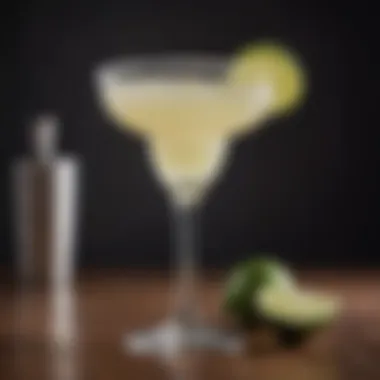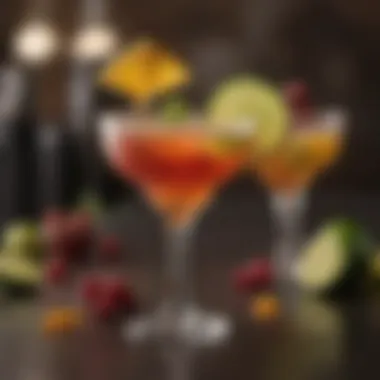Discover Unique Margarita Recipes Without Lime


Intro
The margarita, often celebrated for its zesty lime flavor, has transcended its traditional boundaries over the years. However, a segment of cocktail enthusiasts seeks an alternative, either due to dietary constraints or a desire for new experiences. This article explores innovative ways to prepare a margarita without lime. By delving into unique ingredients and their flavor profiles, one can create a refreshing cocktail that maintains the essence of the original while refreshing it.
Recipe Overview
Recipe Name and Description
Our featured recipe is the Citrus Delight Margarita. This cocktail substitutes lime with a blend of other citrus fruits, delivering a tangy and vibrant taste. The juxtaposition of sweet and sour flavors keeps the drink lively and inviting, making it a perfect choice for various occasions.
Cuisine Type
While fundamentally a Mexican drink, this variation encourages a fusion of global flavors. It appeals not only to the margarita purist but also to those open to culinary experimentation.
Ingredients List
Detailed Ingredient Breakdown
To craft the Citrus Delight Margarita, the following ingredients are necessary:
- Tequila: A good quality reposado tequila is recommended for its rich flavor.
- Orange Juice: Fresh-pressed orange juice offers sweetness and compliments the tequila well.
- Grapefruit Juice: Provides a hint of bitterness that balances the sweetness.
- Agave Syrup: Use to enhance sweetness; quantities can vary based on taste preference.
- Triple Sec: An orange-flavored liqueur to deepen the citrus profile.
- Salt: For rimming the glass, adding a contrast to the drink.
Substitutions for Dietary Needs
For those with specific dietary concerns, here are some alternatives:
- Tequila: Substitute with mezcal for a smoky flavor or an alcohol-free option for a non-alcoholic drink.
- Agave Syrup: Replace with honey or a sugar substitute for a lower glycemic option.
- Juices: Any other fruit juice, such as pomegranate or tart cherry, can be interesting substitutes if seeking different flavor profiles.
This adaptable recipe ensures that everyone can enjoy a refreshing drink, regardless of dietary preferences.
Experimentation does not stop here. Explore variations of this recipe by mixing and matching various fruit juices. The absence of lime could even lead to exciting discoveries in flavor combinations previously unthought of in a margarita. By following this guide, you can broaden your cocktail repertoire while savoring the simple pleasures of a well-crafted drink.
Prelude to the Margarita
The margarita is more than just a cocktail; it is a cultural icon that symbolizes leisure, celebration, and social gatherings. It also holds a significant place in the realm of mixed drinks. This article examines margaritas through a different lens, zeroing in on alternatives to the traditional lime flavor. Understanding the margarita's core components is crucial for anyone interested in elevating their cocktail experience. When you reimagine the drink without lime, it opens doors to new flavor profiles. This exploration encourages both culinary creativity and experimentation.
Historical Context
The origins of the margarita remain shrouded in mystery, making its history particularly intriguing. Some theories suggest that it dates back to the 1930s in Mexico or the U.S. Among popular accounts, one story attributes its invention to a bartender named Carlos Herrara, who mixed the drink for actress Rita Hayworth.
Throughout the decades, the margarita has evolved significantly. It firmly established itself as a staple in bars and restaurants. Over time, various adaptations have emerged; these evolve from the original recipes. Ingredients have varied, reflecting regional preferences and available produce.
The popularity surged in the 1970s and 1980s, especially with the introduction of pre-mixed margarita mixtures. This played a role in making margaritas accessible to a wider audience. The drink now connects with summer barbeques, festive occasions, and casual get-togethers, reinforcing its status as a beloved choice.
The Traditional Lime Margarita
The quintessential margarita typically comprises tequila, lime juice, and orange liqueur. This combination gives a sharp, refreshing flavor, thanks to the acidity of the lime. The balance between the bitterness of tequila and the sweetness of orange liqueur creates a harmonious taste experience.
Traditionalists often advocate for fresh lime juice, emphasizing that bottled versions lack depth. The use of high-quality tequila also cannot be overstated; it greatly impacts the drink's overall taste. The classic margarita serves as a foundation, setting benchmarks against which various adaptations and alternatives can be measured.
However, for individuals looking to step outside the realm of tradition, margaritas without lime offer exciting possibilities. By shifting to alternative ingredients, one can achieve equally delightful results, while maintaining the essence of the classic cocktail.
Defining the Margarita Without Lime
Defining the Margarita without lime is essential for understanding how to innovate this classic cocktail. Lime is traditionally the cornerstone of a Margarita, providing a distinct tartness that defines its flavor profile. However, eliminating lime requires creativity in finding substitute ingredients that can deliver that essential balance—sweetness, bitterness, and acidity. This shift not only broadens the possibilities but also allows for personalization, catering to various palates and preferences.
What Constitutes a Margarita?
A Margarita is generally defined by a few core components: base spirits, sweetening agents, and a defining acidic element. The most popular base spirit is tequila, often accompanied by orange liqueur for added depth. The sweetening agents such as agave syrup help balance the acidity while enhancing the drink's flavor. When lime is removed, the challenge arises to meet the structural requirements of a Margarita without its typical citrus anchor. Replacing lime with alternative fruits or juices not only alters flavor but also introduces new complexity to the cocktail, inviting mixologists to experiment creatively.


One must also consider ratios carefully. A typical Margarita follows a simple 3-2-1 formula: three parts tequila, two parts lime juice, and one part orange liqueur. Without lime, finding an apt substitute and how it affects these proportions needs to be addressed.
Importance of Citrus in Margaritas
Citrus plays a pivotal role in creating a balanced Margarita. The acidity contributes to the overall brightness of the drink, cutting through the richness of the tequila and sweetening agents. It brings freshness and a refreshing quality commonly associated with Margaritas. Without citrus, the cocktail risks becoming cloying or flat, losing the invigorating aspect that makes it so popular.
When redefining a Margarita without lime, one must seek alternative sources of acidity. Ingredients like grapefruit juice, orange juice, or even pineapple juice can provide that necessary tartness and brighten the overall flavor. These alternatives offer unique profiles and can transform a Margarita into a new experience entirely.
"The key to a successful Margarita lies in its balance. Without lime, we must innovate to maintain that essential nature."
By delving into these considerations, readers will gain insight into creating a rewarding Margarita experience that respects traditions while exploring new dimensions.
Common Ingredients in Margarita Recipes
In crafting margaritas, the ingredients play a crucial role in defining the drink's character. By understanding these core elements, one can easily explore variations, including those that do not rely on lime. The quality and type of ingredients often determine the final taste, texture, and overall experience of the cocktail. Each ingredient interacts with the others, creating a symphony of flavors that can be adjusted to personal preferences.
Base Spirits
Base spirits are the foundation of any margarita. Traditionally, tequila is the star of this cocktail, but there are various choices to consider, especially when crafting lime-free versions.
Tequila Types
Tequila comes from the blue agave plant primarily found in Mexico. It has distinct categories, such as Blanco (white), Reposado (rested), and Añejo (aged). Each type offers varying depth and flavor; for instance, Blanco provides a sharp, clean taste, while Reposado offers subtle oak notes from aging.
Choosing the right tequila impacts the entire cocktail. The clean flavors of Blanco tequila are ideal for a refreshing drink, while Añejo may add richness. However, cost and availability can be factors in your selection. High-quality tequila enhances the overall experience, while lower-grade options may lead to less satisfying outcomes.
Mezcal Alternatives
Mezcal shares similarities with tequila but carries its own unique profile. It is made from various agave species and often has a smoky flavor due to traditional production methods involving cooking the agave in underground pits. This characteristic distinguishes mezcal and can add a creative twist to a lime-free margarita.
While mezcal can elevate the flavor profile, it may not appeal to everyone due to its distinctive smokiness. It tends to be more expensive compared to standard tequila and may require more experimentation to complement other ingredients effectively.
Sweetening Agents
No margarita is complete without a sweetening agent. Sweetness balances the cocktail and enhances flavors, especially when traditional citrus is not used.
Simple Syrup
Simple syrup is a classic choice, made by dissolving equal parts of sugar and water. It integrates smoothly into cocktails, providing consistent sweetness without a gritty texture. Since it's easy to make, it is a favored option for many home mixologists.
However, measuring can be tricky for balancing sweetness, and using too much can overwhelm the drink. It is wise to start with small amounts and adjust according to taste.
Agave Nectar
Agave nectar offers a unique sweetness derived from the agave plant. Its flavor profile is less intense than simple syrup and is often praised for its lower glycemic index. Because of this, many view it as a healthier alternative.
Yet, agave nectar can vary in color and taste, impacting the drink's final profile. Some varieties may be overly processed, losing some of the natural characteristics that enhance the margarita experience.
Flavor Enhancers
To further elevate a margarita, flavor enhancers introduce depth and character, creating unique experiences.
Citrus Alternatives
Citrus alternatives, such as lemon or grapefruit juice, can substitute lime and still deliver tanginess. These alternatives provide varying levels of acidity, which can brighten the overall flavor. Lemon juice, for instance, offers a sharper flavor, whereas grapefruit presents a more mellow bitterness.
While they do their job well, they can’t fully replicate the unique zing of lime. However, utilizing them helps maintain that essential tartness necessary in a well-rounded margarita.
Herbal Infusions
Herbal infusions, like fresh basil or mint, can add unexpected twists to margaritas. These herbs impart freshness and can evoke unique flavor profiles, transforming the cocktail into something extraordinary.


This can foster exciting combinations, such as basil with pineapple juice, creating a refreshing take on the classic. Nevertheless, herbal flavors may not appeal to everyone and can easily overpower other elements if used excessively.
Even so, adding a touch of herbal essence can elevate a lime-free margarita into something noteworthy, appealing to adventurous palates.
Crafting a Lime-Free Margarita Recipe
Crafting a margarita without lime offers an opportunity to rethink traditional flavors. This process allows for flexibility and creativity in mixology. Many people have strong attachment to the classic margarita. However, despite its popularity, it can be restrictive. By exploring alternatives, drinkers can discover new profiles that might be equally satisfying or even more enjoyable. Knowing how to substitute lime correctly ensures that the cocktail retains its refreshing quality.
When it comes to lime-free margaritas, the choice of citrus substitute is crucial. The right citrus can provide a balance of sweetness and acidity, which is essential in any margarita. Additionally, understanding how to blend flavors can enrich the drink further. It can elevate social gatherings and personal enjoyment. This makes crafting a lime-free margarita both an art and a science.
Choosing the Right Citrus Substitute
Orange Juice
Orange juice stands out as an accessible alternative. Its sweet and tangy profile makes it a top contender. The key characteristic of orange juice is its natural sweetness, which can complement the spirits well. It is popular because it balances the overall flavor of the margarita. An added benefit is its widespread availability and familiarity among consumers. However, it may lack the sharpness that lime provides, leading to a potentially milder taste.
Frozen Fruit Purees
Frozen fruit purees offer versatility and a unique twist to traditional flavors. They can infuse the margarita with intense fruitiness, making them appealing for different occasions. A key characteristic is their ability to maintain flavor integrity even after freezing. This is beneficial for making cocktails that are adaptable throughout the year. However, overusing fruit purees can make the margarita too thick or jammy, so moderation is crucial.
Pineapple Juice
Pineapple juice is another effective option that brings tropical flair to the cocktail. Its vibrant flavor provides both sweetness and acidity, mirroring the essential qualities of lime. The unique feature of pineapple juice is its ability to create a refreshing, crisp beverage. This option is favorable as it produces a unique margarita experience distinct from traditional ones. Yet, its sweetness can overpower if not balanced correctly with other components in the recipe.
Step-by-Step Recipe
Ingredients List
An ingredients list is essential for any successful margarita. It allows precision and ease in preparing the drink. A well-organized list is highly beneficial as it ensures that everything needed is at hand. Typical ingredients for a lime-free margarita may include:
- Base spirit (Tequila or Mezcal)
- Chosen citrus substitute (Orange juice, Frozen fruit puree, Pineapple juice)
- Sweetening agent (Simple syrup or Agave nectar)
- Optional flavor enhancers (Herbs or spices)
The uniqueness of the ingredients list is that it assists in customization. Ingredients can be adjusted to individual preferences, catering to diverse tastes effectively.
Preparation Instructions
Preparation instructions tie the ingredients together. Clear instructions guide home bartenders through the mixing process. An organized approach minimizes mistakes and enhances the drink's final outcome. To prepare your lime-free margarita:
- Measure out the base spirit (approximately 2 ounces).
- Add your chosen citrus substitute (about 1 ounce).
- Incorporate your sweetening agent (typically half an ounce).
- Shake well or stir to combine the ingredients thoroughly, adding ice if preferred.
- Strain into a glass filled with ice or serve straight up.
These steps provide structure. Each instruction builds on the previous one to ensure the correct balance of flavors.
Garnishing Tips
Garnishing elevates the presentation of the cocktail, making it visually appealing. Simple garnishing tips can transform a basic drink into an enticing offering. The key characteristic of effective garnishing is to enhance without overwhelming. Some suggestions include:
- A slice of fruit on the rim (like orange or pineapple).
- A sprinkle of salt or chili powder around the rim for a touch of spice.
- Fresh herbs like mint or basil for an aromatic touch.
The advantage of garnishing is that it adds an aesthetic value. A well-garnished drink often tastes better, as it engages more senses. However, overdoing it can make the drink appear cluttered and uninviting.
Exploring Flavor Variations
Exploring variations of margarita flavors opens new doors to creativity. It is essential to consider this aspect as it allows for a broader palate experience. Traditional recipes can feel limiting, and replacing lime provides opportunities to explore different tastes. Many enjoy customization. This section seeks to highlight the many fruity and spiced options available. By utilizing unique flavors, one can craft a cocktail that is both enjoyable and distinct.
Fruity Margarita Options
Fruity margaritas have gained popularity because they embody freshness. They provide a contrast to the classic taste. It is relevant to mention that fruity flavors can often balance well with the base spirit, enhancing the overall experience.
Berry Margaritas


Berry margaritas hold a unique spot in the spectrum of margaritas. Incorporating strawberries, blueberries, or raspberries can add vibrant color and sweetness. The tartness from berries contrasts nicely with the usually sweet taste of margaritas. This aspect makes it a beneficial choice. The natural sugars in berries can enhance flavor without additional sweeteners.
However, care must be taken when selecting berries. Freshness matters. Frozen berries may work as well but can alter texture. Besides, it is crucial to puree them effectively for a smooth drink.
Mango Margaritas
Mango margaritas are another interesting option. Mangos provide a rich, tropical taste that enhances margaritas. This appeal lies in their juicy texture. The key characteristic of mango margaritas is their sweetness, which can mask any intensity from the alcohol.
Mango has a smooth consistency that can integrate well in drinks. A downside can be that ripe mangoes can sometimes be hard to find. Yet, for those who enjoy tropical flavors, mango serves as an excellent choice. It supports a balanced margarita experience whilealso bringing a unique twist to the mix.
Spiced Margaritas
Spiced margaritas introduce an exciting dimension to the margarita experience. Using spices can elevate the drink's complexity and invite adventurous flavors. They are worth mentioning due to their potential to astonish the palate.
Using Jalapeños
Jalapeños can be a surprising ingredient. The inclusion of jalapeños offers a spicy kick that contrasts deliciously with the drink's sweetness. This characteristic allows drinkers to enjoy a complex margarita experience. It is particularly benefits those who crave heat. However, it is important to manage spice levels. Overdoing tips can lead to an overpowering flavor.
The advantage of using jalapeños is they add a fresh heat. A disadvantage may be that not everyone enjoys spice. Therefore, it is essential to gauge preferences before introducing jalapeños to your recipe.
Experimenting with Ginger
Experimenting with ginger can bring a zesty twist to margaritas. Ginger adds warmth and a unique sharpness. The key characteristic here is ginger's ability to uplift simpler flavors. This choice can invigorate and refresh the overall cocktail. Ultimately, this benefits many drinkers who look for something beyond the usual.
The unique feature of ginger is its versatility. Fresh ginger, muddled or juiced, can enhance a margarita's flavor profile. However, the balance is critical. Too much ginger can overpower. It is wise to start with small amounts and adjust over time. This experimentation can lead to remarkable choices that challenge the norm.
Adjusting the Margarita's Texture
The texture of a margarita plays a vital role in the overall drinking experience. It is not just about the flavors but how those flavors are presented to the palate. Adjusting the margarita's texture enhances its appeal and can influence the way it is enjoyed. Texture can affect mouthfeel, which is an essential aspect of any cocktail. It can evoke enjoyment and satisfaction, making the drink more memorable. In this section, we will explore two key elements that contribute to texture: serving style and balance.
Frozen versus On the Rocks
When crafting a margarita, the decision between serving it frozen or on the rocks should be made based on personal preference and context. A frozen margarita typically has a creamy, slushy consistency that appeals to those seeking a refreshing treat, especially in warm weather. On the other hand, an on-the-rocks margarita has a more straightforward presentation with ice cubes melting slightly, creating a balance between flavor and temperature.
Some may prefer the latter for its clarity, allowing for the complex flavors to shine through more distinctly. The choice can also depend on the occasion. For celebratory settings, frozen margaritas can add a fun, festive vibe, while on-the-rocks margaritas might suit more formal gatherings.
Maintaining Balance in Thickness
Achieving the right level of thickness is crucial for the ideal margarita texture. Too thick can mask the flavors and make the drink overly heavy, while too thin can lead to a watery experience that is unappealing. Consider the components involved in making the margarita. If using fruit purees, they can enrich the texture. Diluting with ice or liquid can make it lighter, but one must be careful of going too far.
It is also essential to observe how the drink holds up over time. An ideal margarita should maintain its integrity from the first sip to the last. Using a combination of ice types, like larger cubes or crushed ice, can help slow the dilution process. Furthermore, consistently monitoring the balance of your ingredients will ensure that neither the drink’s texture nor its flavor profile suffers.
"Striking a balance in your margarita's texture is the difference between mediocrity and excellence."
Serving Suggestions
Serving suggestions play a crucial role in enhancing the overall experience of drinking a margarita without lime. The manner in which a beverage is presented can greatly influence not only the aesthetics but also its taste perception. Choosing the appropriate glassware, garnishes, and food pairings can elevate your lime-free margarita from a simple cocktail to a culinary highlight.
A well-chosen glass can amplify the flavors and aromas of the drink. For example, traditional margarita glasses are designed to enhance the visual appeal while allowing you to appreciate the drink's aroma. Beyond the glass type, garnishing the drink thoughtfully can add an extra layer of flavor and visual enticement.
Furthermore, pairing food with your margarita is another vital consideration. The right food can complement the flavors within the cocktail, creating a harmonized dining experience. Both Mexican cuisine and seafood options offer unique benefits that pair beautifully with margaritas without lime, providing diverse and appealing flavor profiles.
Instead of seeing your lime-free margarita as an isolated drink, consider it part of a larger dining experience. This perspective can foster creativity in both drink crafting and food pairing, encouraging you to explore and experiment with various culinary options.
Epilogue
The importance of concluding the exploration of margarita alternatives without lime lies in summarizing the multifaceted nature of this classic cocktail. This article has outlined the essential components and the myriad of options available, reinforcing that margaritas can extend beyond the traditional lime and tequila combination. By embracing creativity in flavor and preparation, one can design a drink that satisfies personal tastes while maintaining the essence of a margarita.
The Versatility of Margaritas
Margaritas are not confined to specific ingredients. The versatility they offer allows for countless interpretations, reflecting cultures and personal preferences. For instance, a berry margarita or a mango margarita introduces fresh and vibrant flavors that appeal to various palates. This adaptability makes the margarita a canvas for experimentation, encouraging individuals to find unique combinations that resonate with them. Furthermore, using different citrus substitutes or sweetening agents can drastically alter the cocktail’s profile, creating new favorites even among traditionalists.
"Cocktails are personal. They encapsulate preferences, seasonal availability, and individual creativity."
Encouraging Culinary Experimentation
Encouraging culinary experimentation in the realm of margaritas is pivotal. As food lovers and mixologists alike seek to innovate, exploring alternative ingredients provides opportunities for discovering new favorites. This experimentation can span utilizing different fruit purees to incorporating spice for an unusual twist or even exploring herbal infusions. The process of trial and error can lead to splendid surprises—perhaps a refreshing pineapple margarita or a spicy ginger version. Recipes should not be rigid; flexibility can yield remarkable and enjoyable cocktail experiences.















